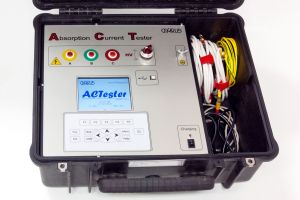AC-Tester – Monitoring Device for Insulation Condition Monitoring and Remaining Insulation Life Assessment

«AC-Tester» (Absorption Current Tester) portable device is used for highvoltage equipment insulation condition assessment off-line. «AC-Tester» device can be used for paper-oil and PE/VPE insulation, for electric motors and transformers insulation monitoring, etc.
In «AC-Tester» device there are three diagnostic methods for insulation absorption parameter evaluation, they are:
1. Absorption factor analysis and polarization factors analysis
The method fits for all types of insulation. In this case the insulation charging current is measured at 15, 60 and 600 seconds. On the base of the measured values the following factors are calculated:
- Absorption factor: K ABC = R60 / R15 (where R is the insulation impedance). Iinsulation of good quality has the absorption factor from 1,3 to 1,8; if the factor is less than 1,3, then the equipment is dangerous to operate.
- Insulation polarization factor: K POL = R600 / R60. The insulation of good quality has polarization factor from 2 to 4. If it is less than 1,5, then the equipment is dangerous to operate.
The «AC-Tester» portable device (Absorption Current Tester) is used for assessment of high-voltage equipment insulation condition off-line. The «AC-Tester» device can be used for paper-oil and PE/VPE insulation, for electric motors and transformers insulation monitoring, etc.
If you imagine high-voltage insulation as a structure of several layers, which have resistance and capacitance, then the K ABC and K POL factors are easier to understand from physical point of view. The current flow passing through the insulation should reduce with time, as the insulation layers get charged. The wetter is the insulation and the more defects are in it, the less is the active impedance and the less is the time during which the layers get charged.
2. Reflected Voltage Measuring (RVManalyze)

The method fits for paper-oil insulation, it is known as voltmeter method. The measurements are taken twice, after the insulation is charged with 1 and then with 2 kV.
The worse is the insulation, the less is the amplitude of the reflected voltage, the quicker it damps. If the curves' form differs much at 1 and 2 kV, then the insulation quality is bad.
3. The Isothermal Relaxation Current method (IRC)
The method fits for of XLPE insulation diagnostics. This is the method of discharge current measuring, it is known as amperemeter method. It is applied after charging the insulation with 1 kV. The curves of discharge currents in the insulation are in the figures below.

The first diagram shows changing of discharge current after test current source switching-off and cable discharging. It is evident that the diagram is difficult to analyze because it has no definite points.
In the second diagram of the same signal on the vertical axis the multiplication of discharge current by measurement time is indicated. The area under this curve is proportional to the charge kept in the insulation. By this curve it is easy to compare the insulations of several objects.
The earlier in the graph a peak is, the worse the insulation condition is, the more wet and polluted it is and the less its remaining life is.
These are not the peak values that are important in this graph but the intervals between the peaks. The earlier the amplitude peak is reached – the worse the insulation condition is. Comparing the insulation condition of one different phases of one object is done in the same way.
Specifications of the "AC-Tester" device
| The number of measuring channels (phases) | 3 |
| PC connection | USB |
| Battery time, hours | 6 |
| Dimensions, mm | 450х520х230 |
| Device weigh, kg | 12 |




